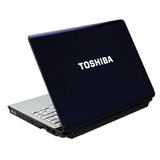Toshiba Satellite U305
Especificaciones de Portátil(es)

Price comparison
Promedio de 1 puntuaciones (de 2 análisis)
Análisis para el Toshiba Satellite U305
Origen: CNet
 EN→ES Archive.org version
EN→ES Archive.org versionThere's a lot to like about the Satellite U305, Toshiba's entry into the fast-growing field of 13.3-inch laptops. Its display size effectively balances readability and portability, and its screen finish provides bright, vibrant images without distracting reflections. Its wide case provides plenty of room for a comfortable keyboard and most of the ports a home user will need. When it comes to performance, the $1,349 U305-S5127 we tested proved it could handle the multitasking that's typical to home use, and its nine-cell battery posted one of the highest battery scores we've seen. Our primary complaints about the Satellite U305 relate to its design; at 1.5 inches thick, it's a bit chunkier than other 13.3-inch laptops. And its case features annoyingly large Toshiba branding.
(von 10): 7.1, Leistung 7, Mobilität 9, Ausstattung 7, Display gut
Único Análisis, disponible online, Mediano, Fecha: 08/27/2007
Puntuación: Puntuación total: 71% rendimiento: 70% características: 70% pantalla: 80% movilidad: 90%
Origen: Notebookreview.com
 EN→ES Archive.org version
EN→ES Archive.org versionThe Toshiba Satellite U300/U305 series is a new 13.3" widescreen notebook that weighs in at just 4.6 pounds and packs solid Intel Core 2 Duo performance and big hard drives with plenty of storage space. Add to that a thin integrated DVD SuperMulti drive, webcam, and fingerprint reader and this notebook starts looking even better. Is Toshiba justified in calling the U305 "the ideal concentration of performance and design?" Let's take a look. The Toshiba U305 is an impressive portable notebook that is handicapped by a few minor issues. The quality 13.3" glossy display, thin and light lines, sizeable hard drive, good battery life and a good selection of ports help provide a solid foundation for a portable powerhouse. The Core 2 Duo processor and plenty of available RAM likewise give the system an impressive backbone for performance. However, integrated graphics, limited selection of processors, and too much bloatware prevent the U300 and U305 notebooks from offering jaw-dropping performance. The keyboard and touchpad issues also make the notebook feel less refined than it could be.
Leistung mäßig, Mobilität gut, Display gut, Verarbeitung mangelhaft
Análisis del Usuario, disponible online, largo, Fecha: 08/22/2007
Puntuación: rendimiento: 60% pantalla: 80% movilidad: 80% procesamiento: 50%
Comentario
Intel Graphics Media Accelerator (GMA) X3100: Intel Graphics Media Accelerator (GMA) X3100 es un chip de video integrado (incorporado) en un chipset de Mobile Intel 965GM (para Merom =Core 2 arquitectura). Es el sucesor del Intel GMA 950. Lo más interesante es la integración de un pipeline completamente programable. Debido a la integración de características Direct X9, HDR y Hardware Transform & Lighning (T&L) – su predecesor solo tenía Software T&L – debería estar listo para Windows Vista Premium (soporte Aero Glass completamente). Con respecto a los datos, el rendimiento debe ser claramente mejor al de GMA 950.
Muchos juegos son difícilmente ejecutables con estos adaptadores gráficos o se ejecutan de manera muy lenta.
>> Más información puede ser encontrada en nuestra comparación de tarjetas gráficas moviles y la lista de benchmarks.
Intel Core 2 Duo: Este es el sucesor Core Duo y el Core Solo con un pipeline más largo y con una velocidad entre 5-20% sin mayor consumo de energía. Adicional al diseño de Core Duo existe un cuarto decodificador, una unidad SSE ampliada y una unidad lógica aritmética (ALU) adicional.
Sus características son: 2 núcleos (cores), una amplificación de comando de 64-bit EM64T y 2 o 4 MB L2 Cache y 291 millones de transistores, que son acabados en 65nm. Mas allá de esto, todos los tipos soportan técnicas "Execute Disable Bit", SSSE3 (SSE4), Enhanced Speedstep, LaGrande y la mayoría de técnicas de virtualizacion (VT) Vanderpool.
El Core 2 Duo para laptops es idéntico a los procesadores Core 2 Duo para desktops, pero los procesadores para notebooks trabajan con tensiones más bajas (0.95 a 1188 Volt) y un Frontside bus clock (1066 contra 667 MHz). El rendimiento de laptops cuena con una frecuencia de 20-25% más baja que PCs Desktop debido a una frecuencia más baja de Frontside bus y los discos duros más lentos.
T7100:
>> Más información puede ser encontrada en nuestra comparación de procesadores móviles.







